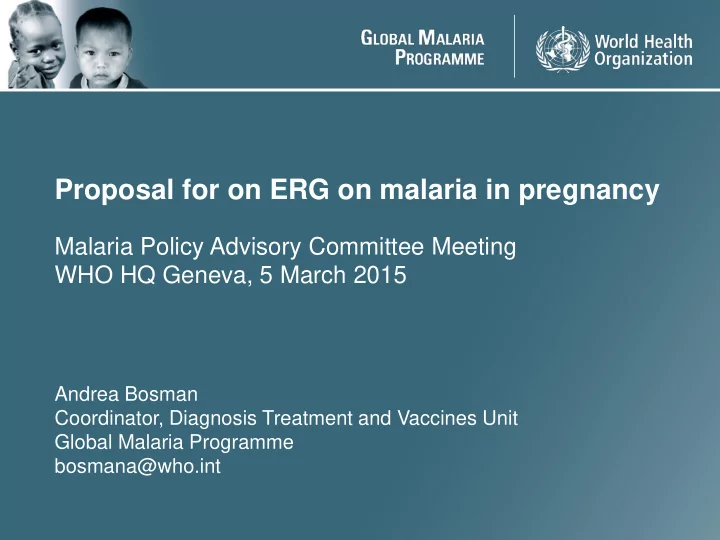

Proposal for on ERG on malaria in pregnancy Malaria Policy Advisory Committee Meeting WHO HQ Geneva, 5 March 2015 Andrea Bosman Coordinator, Diagnosis Treatment and Vaccines Unit Global Malaria Programme bosmana@who.int 1 1
New WHO IPTp policy in October 2012: status of implementation in 2013 2 2
2nd Evidence Review Group in July 2013 To respond to concerns on the effectiveness of IPTp-SP in areas with Plasmodium falciparum antifolate resistance or decreasing malaria transmission, and to evaluate the role of potential alternatives to IPTp-SP. In September 2013 MPAC recognized that in few areas of eastern and southern Africa, where P. falciparum parasites carry sextuple resistance mutations in dhfr and dhps genes (including the A581G dhps mutation), IPTp-SP may no longer be effective in preventing low birth weight. However, in many areas with high prevalence of parasites with quintuple antifolate mutations IPTp with SP still confers some benefit in terms of pregnancy outcomes. On balance, MPAC concluded that there is currently insufficient data to determine at what level of SP resistance, IPTp-SP should be discontinued in the absence of an established and effective alternative. MPAC also concluded that there are currently insufficient data to define the level of P.falciparum transmission at which IPTp-SP may cease to be cost-effective from a public health point of view. 3 3
New emerging evidence During the past two years, several studies have evaluated the efficacy, safety, feasibility, acceptability, and cost-effectiveness of intermittent screening and treatment of malaria in pregnancy (ISTp) to prevent the consequences of malaria in pregnancy. This intervention uses RDTs for screening of pregnant women and treatment with an effective antimalarial, i.e. SP, AS+AQ, DP (dihydroartemisinin + piperaquine) or AL (artemether + lumefantrine). Meta-analyses have been completed to evaluate the comparative effectiveness of IPTp-SP with ISTp-AL and ISTp-DP in areas with different levels of SP resistance and malaria transmission. More evidence has been accumulated on the safety of the artemisinin derivatives in the first trimester of pregnancy , compared with quinine, and to non exposure to malaria and antimalarial treatment, as well as on the efficacy of different ACTs for the treatment of malaria in pregnancy. 4 4
Manuscripts for WHO MIP-ERG July 2015 Is IST a potential alternative strategy to IPT-SP in areas with low malaria transmission or high SP resistance? o Efficacy (ISTp-AL; ISTp-DP; ISTp-DP vs IPTp-DP, ISTp-ASAQ vs ISTp-SP) o Safety & Tolerance (DP in pregnancy, DP for malaria treatment in pregnancy) o Cost-effectiveness analyses of trial data o Feasibility and acceptability o Acceptability under trial conditions o Feasibility under real-life conditions Impact, SP Resistance and Transmission intensity and threshold maps for potential implementation o Meta-analyses impact of resistance and transmission on IPTp-SP o Modelling impact and threshold maps for IPTp-SP and ISTp-DP or AL Artemisinin safety 5 5
Pooled analysis for assessment of safety of exposure to artemisinin derivatives in the 1st trimester of pregnancy The 561 documented first trimester exposures for IPD pooled analysis would confer statistical power to detect RR of ≥ 2.5 for major malformations and a RR of 1.4 for miscarriages (assuming 0.9% for major malformations detectable by surface examination at birth and 10% for miscarriage with ratio of exposed to unexposed of 1:5 at 80% power). With additional 300 first trimester exposures from SMRU (McGready personal communication), RRs of 1.3 for miscarriage and 2.2 for major malformations could be detected. 6 6
MPAC discussion Proposed plan for review and selected studies 7 7
Recommend
More recommend